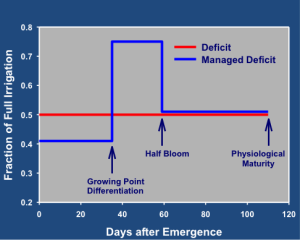by Jourdan Bell, AgriLife Extension Agronomist, Amarillo
The ample rainfall during the 2015 cropping season has allowed many Texas High Plains producers to significantly reduce their number of irrigations, but in an average year, irrigation is necessary to minimize production risks. However, on the Texas High Plains, well capacities are declining and producers are having to make critical decisions on how to manage limited water resources to optimize production. In grain sorghum, irrigation is commonly applied at a fraction of the crop water requirement throughout the season (deficit irrigation). However, in a three-year study on a clay loam soil at Bushland, our research found that concentrating irrigation during critical growth stages (managed deficit irrigation) maximized yield. Using a managed deficit irrigation strategy, yield was maximized by increasing the number of seeds per panicle in two of three years. Grain sorghum yield is a function of the number of seeds per head (63%), number of heads per acre (30%), and seed size (7%). While peak water use occurs around the boot growth stage, irrigation targeting the critical growth period between growing point differentiation and half-bloom is the critical period to increase yield with this strategy because seeds per head make a proportionally higher contribution to yield. Growing point differentiation occurs approximately 30 days past emergence when there are seven to ten leaf collars visible. At growing point differentiation, the number of seeds per head is being determined. Half-bloom occurs when 50% of the plants are blooming.
With a managed deficit irrigation strategy, two early season irrigation events prior to growing point  differentiation were eliminated in comparison to a deficit rate at 50% of the crop water demand. From growing point differentiation through half-bloom, irrigation was approximately 75% of the crop water demand, and from half-bloom through reproductive maturity, irrigation was applied at a deficit rate. While management was intensified, the cumulative seasonal irrigation was comparable between the deficit and managed deficit strategies.
differentiation were eliminated in comparison to a deficit rate at 50% of the crop water demand. From growing point differentiation through half-bloom, irrigation was approximately 75% of the crop water demand, and from half-bloom through reproductive maturity, irrigation was applied at a deficit rate. While management was intensified, the cumulative seasonal irrigation was comparable between the deficit and managed deficit strategies.
By reducing the early season irrigation events with a managed deficit irrigation strategy, early season evaporative losses from the soil surface prior to canopy closure were minimized. And while deficit irrigation was a fraction of full irrigation (100% crop water demand), the same irrigation depth was applied but at different intervals in the Bushland study. In doing so, evaporative losses of irrigation intervals less than one inch were also minimized. While this complicates irrigation scheduling, it was a more valid approach than applying frequent irrigations of one-half inch or less. Grain yield and seeds per head were greatest in all years under full irrigation; however, these components were significantly greater under the managed deficit irrigation than the deficit irrigation in two of the three years. Under normal precipitation and in-season temperatures (2010), the effect of irrigating at the critical growth stages was not significant because the crop was not stressed during the period of growing point differentiation. However, under extreme drought and heat stress of 2011 and 2012, yield and seeds per head were significantly greater. This research and the associated management implications provide a valid management strategy to optimize irrigated grain sorghum yield.

FI=Full Irrigation; MDI=Managed Deficit Irrigation and DI=Deficit Irrigation
While this strategy is valid on fine textured soils, it needs to be evaluated on a coarse textured soil with nominal soil moisture storage capacity. Additionally, this strategy requires a greater well capacity than would be required by a traditional deficit strategy if irrigating a large area. However, it is ideal in a split pivot scenario and allows the producer flexibility in irrigating secondary crops.

Jourdan Bell
Assistant Professor and Extension Agronomist
Dept. of Soil&Crop Sciences
jourdan.bell@ag.tamu.edu
